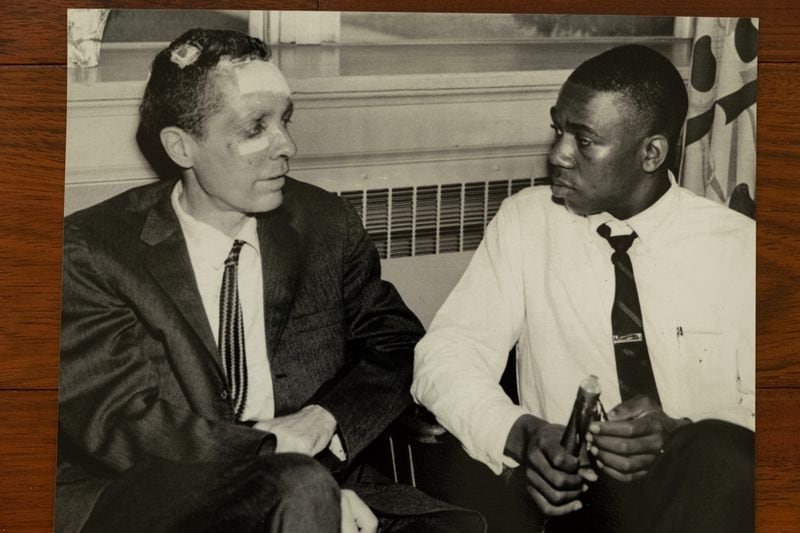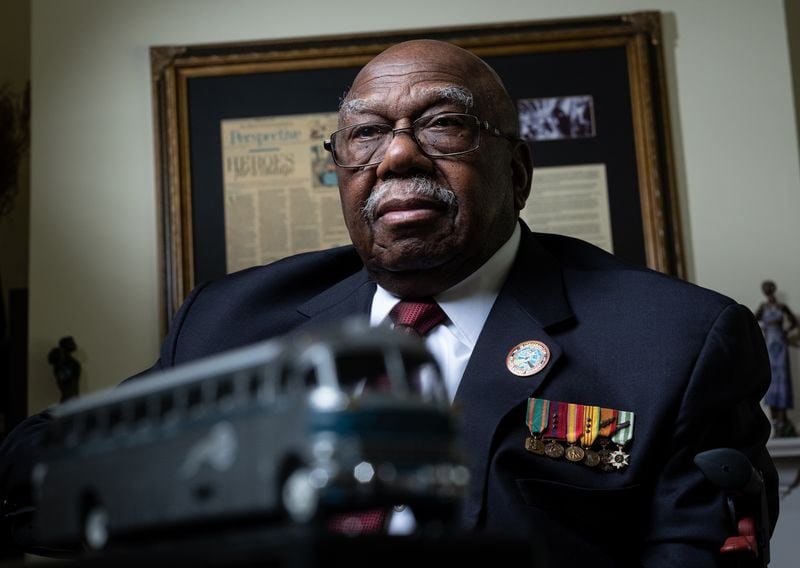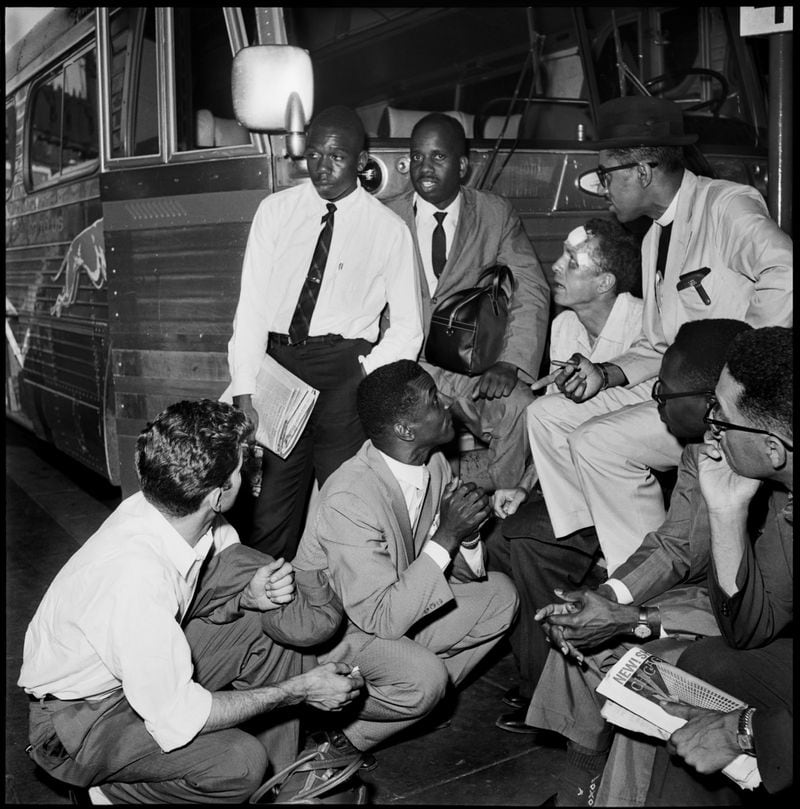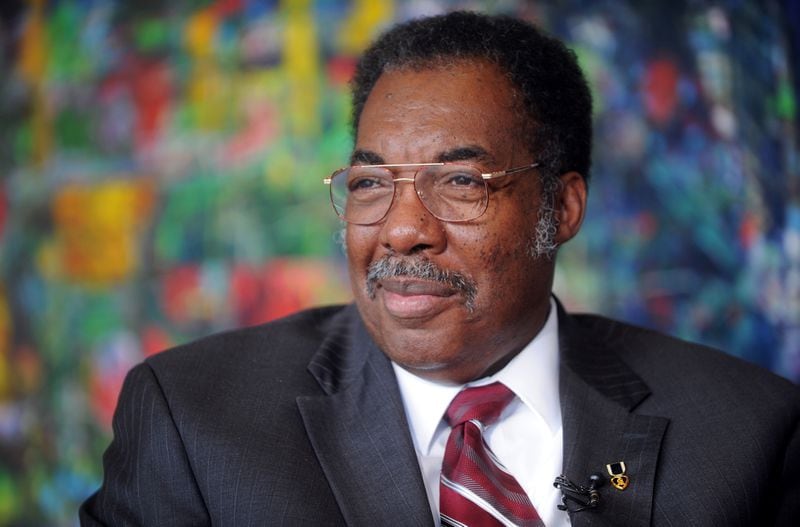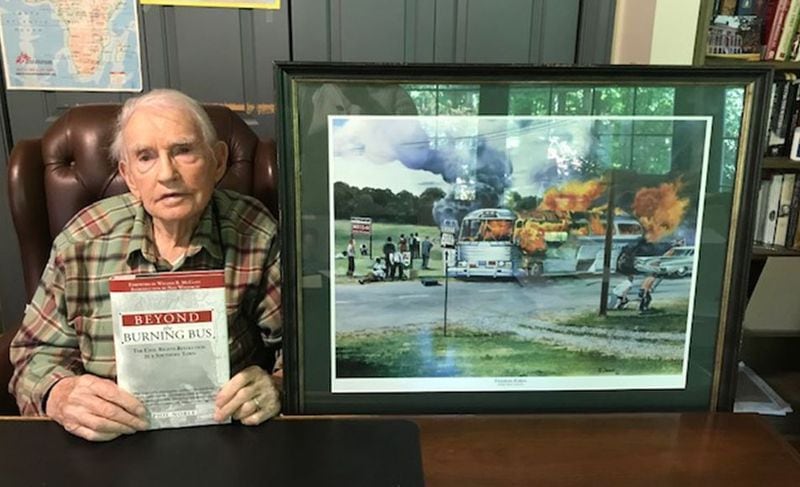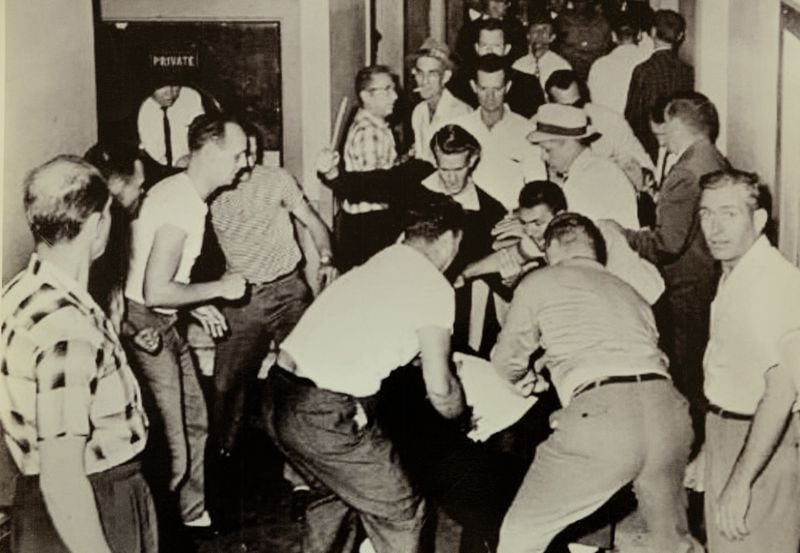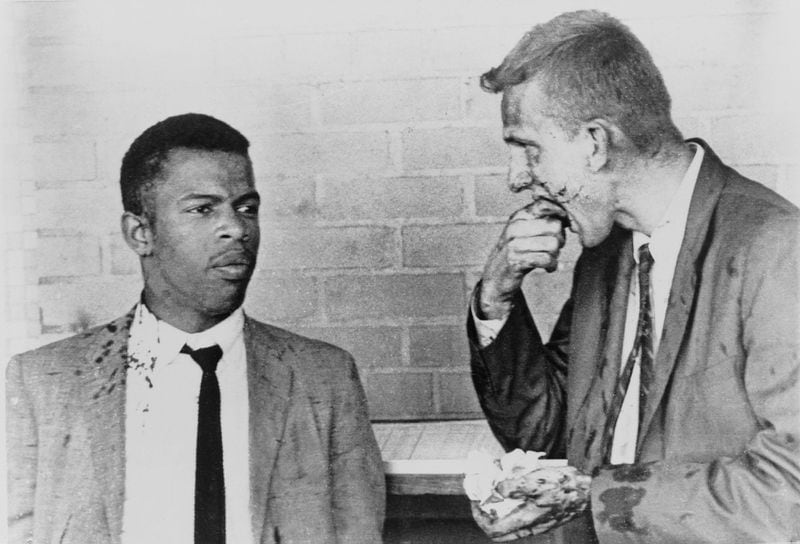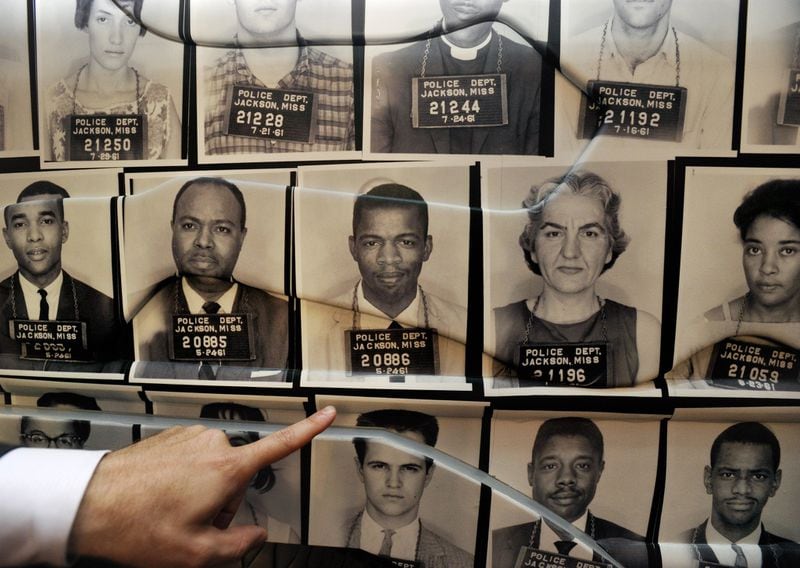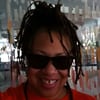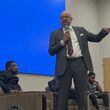Sixty years ago on May 4, Charles Person boarded a bus in Washington, D.C., to take the most dangerous ride of his life.
With him were 12 other Freedom Riders, spread between two buses — one group on Trailways and another on Greyhound destined for Louisiana.
Seven Black activists and six white activists. Men and women.
They rode to test a December 1960 Supreme Court ruling on Boynton v. Virginia that banned segregation in interstate travel. Complete desegregation should have meant they could use waiting rooms, dining facilities and restrooms along the way.
Other Freedom Riders — more than 400 over time — would follow, but among this original 13 was John Lewis, who later went on to become a well-respected congressman from Georgia; and James Peck, a pacifist and civil rights activist.
Lewis died in 2020 after a battle with cancer; Peck died in 1993.
Credit: P.A. Hughes for Times-Picayune
Credit: P.A. Hughes for Times-Picayune
Of the first 13, only two are still alive — Person and Henry “Hank” James Thomas — both of whom live in Georgia.
Their stories became a key part of the civil rights movement and illustrate the courage and determination of those who rode, many of whom were already involved in student movements and efforts to integrate other facilities.
‘Probably too naive to be afraid’
Organized by the civil rights organization Congress for Racial Equality, the first group of Freedom Riders’ destination was New Orleans, where there would be an observance of the 1954 Supreme Court ruling on Brown v. Board of Education. To get there, the group of activists had to travel through South Carolina, Georgia and Alabama, what was often hostile territory for Black people and liberal-thinking whites.
Led by CORE’s national director, James Farmer, they had been trained in passive resistance — not to respond to the angry taunts they were likely to encounter and even the physical violence, such as spitting, pushing or strikes with fists, bats, wooden boards or metal objects.
Person and a friend heard about plans for the Freedom Rides while he was a college student. Person was accepted. Ironically, he took a bus to Washington, D.C., and dutifully abided by segregationist policies like where to sit on the bus.
Credit: Ben Gray
Credit: Ben Gray
He saw the irony that soon he would be on a bus challenging those very policies, he writes in the newly released book “Buses Are A Comin’: Memoir of a Freedom Rider,” co-written by Person and Richard Rooker, an educator, writing coach and friend of Person’s.
He recalls in his book that civil rights activist Julian Bond told him then “this will be the last time you ride in the back of the bus.”
For the Freedom Rides, a Black rider was to sit in front, then an interracial pairing would sit together, another rider served as an observer, playing the role of a regular passenger, according to the book.
Along the way, they were beaten, some jailed and one group barely escaped a bus that was firebombed outside Anniston, Alabama. The first violent welcoming was in Rock Hill, South Carolina.
“I was probably too naive to be afraid,” said Person, who now lives in southwest Atlanta with his wife, Joetta.
“They wanted to see if the law was going to be respected,” said historian and author Karcheik Sims-Alvarado. “African Americans were advocating for their freedom of movement because since Reconstruction, their freedom of movement had been monitored and restricted. And what they (the Freedom Riders) did was extremely dangerous. You have Freedom Riders going into the Deep South and challenging Jim Crow law, customs and traditions and they could actually lose their lives in the process.”
‘We had a job to do’
It wasn’t the first time buses had been used in the struggle against segregation.
In the 1947 Journey of Reconciliation, Black and white bus riders tested an earlier Supreme Court ruling that determined segregated bus seating was unlawful.
In the 1961 action, the perilous journey began on May 4. Riders under the age of 21 were required to get permission from their parents.
“I was probably too naive to be afraid."
Person, then an 18-year-old freshman at Morehouse College and the youngest of the original 13, knew that it might be hard to get permission.
“It was time to lie,” he writes in his memoir.
He told his father about the bus ride, but said it would not be dangerous. After all, Person reminded him, they were getting training in passive resistance. He promised he could make up missing his finals at Morehouse, although no one at the school had given that assurance.
Person, who grew up in Atlanta, a few blocks from where the Rev. Martin Luther King Jr. was raised, was the great-grandson of slaves and planned for a career as a nuclear physicist.
“It started out as a good day,” said Person, 78, a retired lieutenant in the U.S. Marine Corps and former electronics technician for the Atlanta Public School System. “We were anxious to get on the road, really.”
“I had mixed feelings, not knowing truly what to expect. There was role playing. Reenactments. We had practiced several scenarios and what we experienced far surpassed that training. We didn’t know the Klan in Alabama had other things in mind. We took their best shot.”
There were strict steps to follow: Don’t talk back if you were yelled at by hostile — and sometimes violent — white people. Don’t resist.
There was a “Sunday best” dress code. Men wore sports coats or suits; women wore dresses or skirts.
Credit: AP
Credit: AP
Riders had to be off the roads at night. In the cities where they stopped, they stayed in the homes of local supporters and were fed by churches. They alternated buses.
Person remembers in Atlanta they met with a group that included King, who issued a warning.
“Dr. King told us that word was out and that danger was awaiting us in Alabama,” Person said. “He said, ‘I don’t think you guys will make it out of Alabama’ (without violence).”
It was serious.
“Dr. King didn’t joke. Not like that. It would get so bad that some people thought we would not be able to continue to Mississippi and Louisiana, but we had a job to do. We respected Dr. King, but still. We had some very dedicated and seasoned people with us. They said they would take care of me and they tried.”
They sang. They prayed. He got to visit with his mother, a domestic worker, briefly on Mother’s Day morning, then it was on the road again.
Determined to stand up for rights
Like Person, Henry “Hank” James Thomas, who was born in Jacksonville, Florida, and raised in segregated St. Augustine, was one of the 13 on that first Freedom Ride.
Thomas was sometimes jokingly referred to as that “crazy Henry James,” because even as a teenager in the 1950s Deep South, he tested the waters of activism.
He refused to sit in the back of the bus, he drank from the whites-only water fountain (first making sure no one was looking), went to the library (he wasn’t allowed to check out books, so he took his own) and corrected white people who called his mother and aunt by their first names.
“When you’re that age, you’re not really that much aware of what the dangers are,” said Thomas, 79, now of Stone Mountain, a civil rights activist, entrepreneur and philanthropist. “I never knew anybody who had been roughed up by the police or lynched. That may have happened but I wasn’t aware of it. St. Augustine was not a typical Deep South city. Had I done those things in Birmingham or Montgomery, I never would have survived.”
Resistance was in his blood.
Credit: bhonarvar@ajc.com
Credit: bhonarvar@ajc.com
An aunt had to leave Georgia because she talked back to a white man. His uncle was threatened with lynching because he attacked a white man who insulted his wife.
He participated in lunch counter sit-ins in Maryland and Virginia and was one of the founders of the Student Nonviolent Action Group at Howard University.
“Standing up for my rights is part of who I am,” said the 6-foot-4-inch Thomas, who said his size could sometimes intimidate racists hellbent on causing trouble. “I never had a smile on my face,” he said, chuckling.
The first incident of serious trouble was in Rock Hill, South Carolina, where Lewis was badly beaten.
When he saw Lewis attacked in the Greyhound bus terminal, Thomas admitted it “unnerved me, but we’re trained to simply not to interfere.”
Next was Winnsboro, South Carolina. The riders had alternated testing the waters. A Black Freedom Rider might go into the bus station’s whites-only waiting room or vice versa. They might try to get a meal in the restaurant or counter.
Many times, police would not show up right away to give mobs a chance to beat the riders.
This time it was Thomas’ turn.
A group of white people were already there, yelling and screaming.
“I wasn’t too happy, but I got off,” he said. “Once again, I thought, considering my size, they might have second thoughts about attacking me. I’m not the prettiest guy in the world and I always had a mean look on my face.”
Credit: Anonymous
Credit: Anonymous
He headed toward the whites-only men’s restroom. As soon as he got there, he was arrested and hauled off to jail. Hours later, three officers unlocked his jail cell and took him out. It was dark. His stomach dropped.
“I knew this was not going to come to any great end,” he said. They wouldn’t say where they were taking him nor would they let him make a call.
He was placed in a cruiser and the officers headed toward the now-closed bus station, where a crowd had gathered. One officer put his hand on his pistol and using a racial slur ordered Thomas out of the car or risk a bullet in the head.
“Dr. King told us that word was out and that danger was awaiting us in Alabama. He said, ‘I don't think you guys will make it out of Alabama' (without violence)."
He jumped out and started running in the opposite direction from the mob, when a car pulled alongside him. The Black driver, a minister who had been secretly watching the jail and followed the cruiser with Thomas inside, yelled for him to get in the car on the floor and “don’t get up.”
He expected to hear bullets shattering the rear window at any minute.
The minister drove him to Benedict College in Columbia, where he stayed a couple of days before rejoining the group in Atlanta.
“They didn’t know what had happened to me,” he said. “The police said they didn’t know anything about me being arrested. (His fellow riders) thought I had been lynched.” He was not formally booked.
Attacks on riders escalate in Alabama
From Atlanta, Thomas and the others headed to Anniston and Birmingham, where some of the worse violence would occur.
Anniston, about 91 miles west of Atlanta, was a “real hot spot for the Freedom Riders,” said the Rev. J. Phillips Noble, a retired Presbyterian minister and a white civil rights activist who lived in the city at the time.
Noble himself was often a target of hate. Noble said he was later told by the FBI that he was on the Ku Klux Klan’s hit list. And every morning before taking his children to school, he would check under the hood of his car to make sure there wasn’t a bomb.
“It was harsh Jim Crow and segregation to the nth degree,” said the 99-year-old Noble, who now lives in Decatur.
It was May 14, Mother’s Day.
Credit: Contributed
Credit: Contributed
When one of the buses arrived in Anniston, a white mob surrounded it, and no one got off the bus at the station.
White segregationists had slashed the tires on the bus and it had to stop a few miles outside of Anniston. The mob jammed the doors, broke the windows and threw a firebomb on the bus.
“Where were the police?” asks Thomas. “The crowd was there to lynch us. Back in those days, you either feared the police or you feared the crowd. These are people who had just returned from church on Mother’s Day and they had their children with them. They were there to watch the Freedom Riders get lynched.”
Within minutes, the bus filled with smoke. One of the riders, a retired Navy veteran, shouted for them to get on the floor so they could get oxygen, but that only lasted a few minutes.
Thomas sprinted to the front of the bus. At that moment, the back of the bus blew out. Those outside backed away, allowing the riders to get off the bus.
“Where were the police? The crowd was there to lynch us."
The crowd regrouped and beat them. Thomas thinks he was beaten with a baseball bat and was knocked to the ground. For the second time on the ride, he was terrified.
Later, said Noble, author of “Beyond the Burning Bus: The Civil Rights Revolution in a Southern Town,” the general impression among many whites “was we’re glad it happened, but sorry it happened in Anniston.”
A couple of years later, the city formed the biracial Human Relations Council with Noble as its chairman. The mayor at the time advised him not to publicize when and where they were meeting, so it wouldn’t be bombed as well.
In Birmingham, it was much the same.
There, Person was brutally beaten.
Credit: Ben Gray
Credit: Ben Gray
“Even when they were beating me, I didn’t yell out. I didn’t cry. I didn’t cover up,” he said. He played sports in high school, so he knew how to take a blow and how to use his body to deflect.
Perhaps the most damage was done by a man who wielded a metal pipe. Years later, Person would still have medical issues from the beating — tissue damage at the base of his skull that would cause a knot to swell and had to be drained. It was finally removed in 1996.
Person had to leave the rides before they got to Mississippi to testify in the trial of one of his attackers, but Thomas continued on to Montgomery and Jackson, Mississippi. In Montgomery, they were met by another angry mob, and several, including Jim Zwerg, a white college student, and John Lewis were seriously injured.
The moment they stepped off the bus in Jackson and tried to desegregate facilities, they were jailed. Later, Thomas and others were taken to the notorious Mississippi State Penitentiary, often referred to as Parchman Farm in Parchman, Miss.. For the riders, the strategy was if they were arrested, not to post bail, thereby filling up the cells.
Credit: Everett Collection Historical
Credit: Everett Collection Historical
“They had a special treatment for us,” Thomas said of local jail authorities. “I was beaten because I wouldn’t say ‘yes, sir’ or ‘no, sir.’” In Parchman, “I was put in solitary confinement and given two slices of white bread and a cup of water.”
During one of the anniversaries, Thomas went back to Parchman. He said he went to his old cell and discovered it was exactly 65 feet away from the electric chair.
“It was an eerie feeling,” he said. “I had to just stand there and think of the number of Black people who had been electrocuted in that state. I was pretty sure they were not going to electrocute me, they just wanted me to know how serious my violation was.”
A legacy that can’t be ignored
The purpose of the Freedom Rides “was not just to simply desegregate transportation, it was to stir people up and get them to exercise the rights they already had to ride the bus in an integrated way,” said Bernard LaFayette Jr. of Tuskegee, Alabama, who’s chairman of the board of the Southern Christian Leadership Conference.
He was part of a second wave of Freedom Riders out of Nashville.
After the bus was burned in Anniston and riders were attacked in Birmingham, another group that included LaFayette asked if they could take up the mission. Things there were so tense, he said they even made out their wills. From Birmingham, LaFayette and others went to Montgomery, where they were attacked by a white mob.
Credit: David Tulis
Credit: David Tulis
The legacy of the Freedom Riders can’t be overstated. Person said he has been contacted by two separate group who are working on film projects on the Freedom Riders, including one involving attorney Ben Crump. One of the two groups is also considering a series.
The violence that met the riders in some cities drew international attention, embarrassing some local and national leaders and business leaders.
“The rides expanded the movement and brought in a significant number of people from around the country — Black people as well as white people — who had never participated in any kind of movement before,” said Eric J. Etheridge, an American journalist, photographer and author of “Breach of Peace: Portraits of the 1961 Mississippi Freedom Riders”. “Once they saw the pictures from Alabama and Mississippi, they got involved, then they went home at the end of summer and became activists.”
The rides “expanded the movement and gave them a success. They opened up bus stations. They won.”

